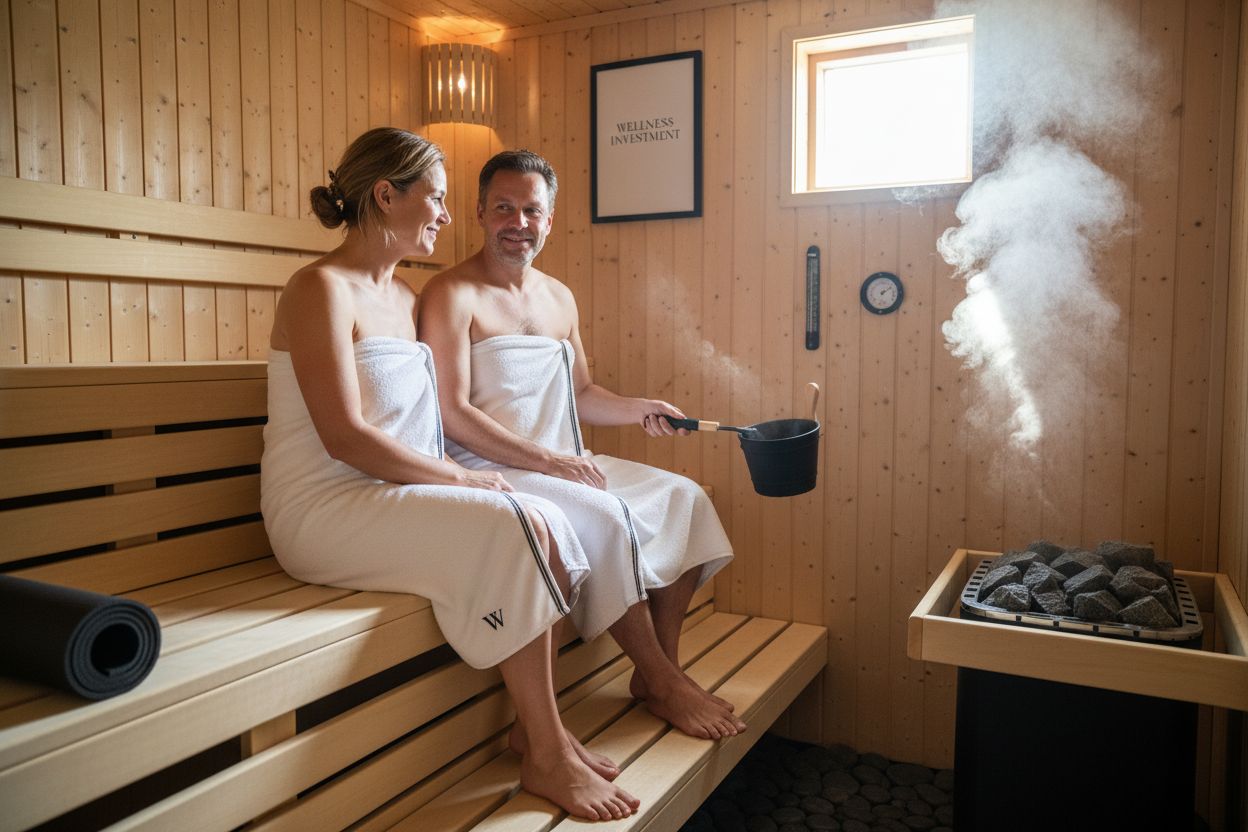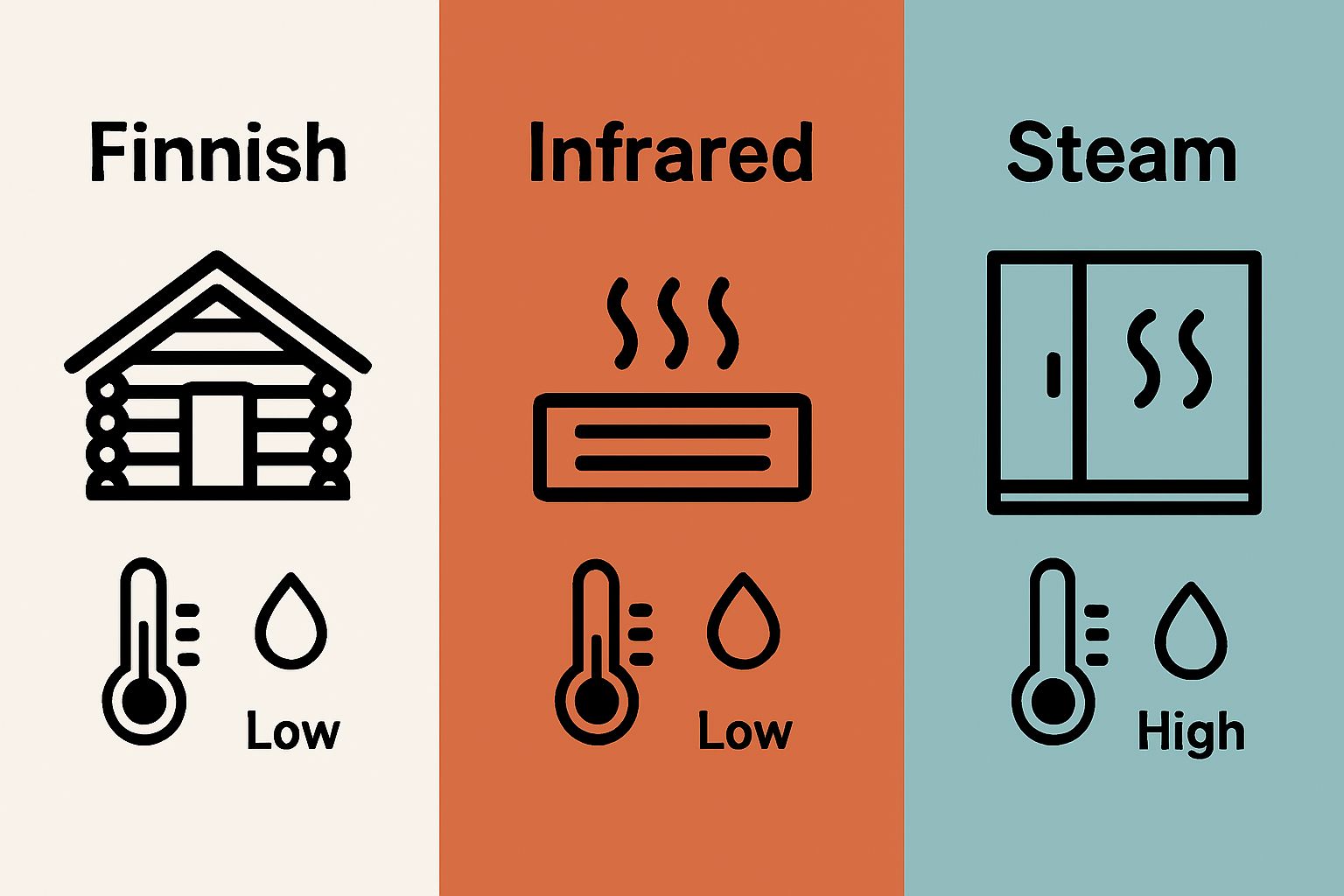
Understanding Sauna Types Explained for Wellness Seekers
Saunas have been soothing mind and body for centuries but their true power goes far beyond a simple sweat session. Most people only know about the classic wood-smoked rooms from Nordic tradition. Yet, infrared saunas work at just 110 to 140 degrees Fahrenheit and can reach deeper tissue layers than traditional designs. This means your choice of sauna does more than affect your comfort level. It could actually shape your recovery, stress relief, and long-term performance in ways that might surprise you.
Table of Contents
- What Are The Different Types Of Saunas?
- Why Sauna Choice Matters For Health And Wellness
- How Each Sauna Type Works: Key Concepts Explained
- Comparative Benefits Of Popular Sauna Types
- Real-World Applications Of Saunas In Daily Life
Quick Summary
| Takeaway | Explanation |
|---|---|
| Choose sauna type based on health goals | Different saunas offer unique benefits; select one that aligns with your wellness objectives. |
| Finnish saunas promote cardiovascular health | These saunas generate high heat stress, enhancing heart function and stress reduction. |
| Infrared saunas target deeper tissue recovery | They use lower temperatures to penetrate tissues, supporting muscle recovery and detoxification. |
| Steam rooms enhance respiratory and skin health | High humidity in steam rooms aids in hydration and promotes respiratory function, creating relaxation. |
| Consistent sauna use boosts overall wellness | Regular heat exposure improves immune function, circulation, and serves as an effective stress management tool. |
What Are the Different Types of Saunas?
Saunas have been integral to wellness practices for centuries, offering therapeutic benefits through heat exposure and relaxation techniques. Understanding sauna types explained across different categories helps wellness seekers choose the most suitable experience for their health goals.
Traditional Finnish Dry Saunas
Traditional Finnish dry saunas represent the classic sauna experience originating in Nordic cultures. These saunas use wood burning or electric heaters to generate intense dry heat, typically ranging between 170 to 200 degrees Fahrenheit. Participants experience profound sweating and muscle relaxation through high temperature and low humidity environments. According to Mayo Clinic, these saunas provide significant cardiovascular and stress reduction benefits.
Key characteristics of traditional Finnish saunas include:
- Extremely high temperatures between 170 to 200 degrees
- Low humidity levels below 20%
- Wood or electric heating elements
- Typically constructed from wooden interiors
Infrared Saunas
Infrared saunas represent a modern wellness technology that differs substantially from traditional heat exposure methods. Instead of heating the air, infrared saunas use electromagnetic waves to directly warm body tissues. These saunas operate at lower temperatures around 110 to 140 degrees Fahrenheit, making them more accessible for individuals sensitive to extreme heat.
The unique heating mechanism allows deeper tissue penetration, potentially offering enhanced therapeutic benefits such as improved circulation, muscle recovery, and cellular detoxification.
Infrared technology enables more prolonged and comfortable heat exposure compared to traditional sauna approaches.
Steam Rooms and Wet Saunas
Steam rooms and wet saunas provide a dramatically different experience characterized by high humidity and lower temperatures. These environments generate moisture through water vapor, creating a wet heat experience that promotes respiratory health and skin hydration. Temperatures typically range between 110 to 120 degrees with nearly 100% humidity, offering a distinctly different sensation from dry heat saunas.
Wellness enthusiasts often appreciate steam rooms for their ability to open pores, support respiratory function, and create a profoundly relaxing environment.
To help you easily compare the major sauna types discussed, the following table summarizes their core features, heat mechanisms, typical temperature ranges, and distinct benefits.
| Sauna Type | Heat Mechanism | Typical Temp (°F) | Humidity | Key Benefits |
|---|---|---|---|---|
| Traditional Finnish Dry | Wood/Electric Heater (Air) | 170-200 | Low (<20%) | Cardiovascular health, stress reduction |
| Infrared | Electromagnetic Waves | 110-140 | Low | Deep tissue recovery, detoxification |
| Steam Room / Wet Sauna | Steam Generator (Moist Air) | 110-120 | High (~100%) | Skin hydration, respiratory health, relaxation |
Why Sauna Choice Matters for Health and Wellness
Selecting the right sauna is not merely about comfort but involves strategic decisions that impact overall physical and mental wellness. Different sauna types offer unique physiological responses, making informed selection critical for achieving specific health objectives.
Personalized Health Optimization
Individuals have diverse health requirements, which means a one size fits all approach to sauna selection becomes counterproductive. Research from the National Institutes of Health indicates that targeted heat therapy can produce significantly different metabolic and cardiovascular outcomes depending on the sauna technology used.
Considerations for personalized sauna selection include:
- Individual cardiovascular health status
- Specific wellness and recovery goals
- Temperature and humidity tolerance
- Existing medical conditions
- Fitness and athletic performance objectives
Physiological Response Variations
Each sauna type triggers distinctive physiological responses within the human body. Traditional Finnish dry saunas generate intense heat stress, prompting robust cardiovascular adaptations. Infrared saunas, conversely, penetrate deeper tissue layers, potentially offering more targeted cellular benefits such as enhanced mitochondrial function and improved metabolic efficiency.
The nuanced differences between sauna technologies mean that wellness seekers can strategically choose environments that align most closely with their personal health optimization strategies. Athletes might prefer different sauna experiences compared to individuals seeking stress reduction or detoxification.
Long Term Health Investment
Choosing the appropriate sauna represents a proactive approach to preventative healthcare. Regular, intentional heat exposure through carefully selected sauna experiences can contribute to improved immune function, enhanced circulation, and reduced inflammation. Consistent sauna use, when matched to individual physiological needs, transforms heat therapy from a passive experience into an active wellness intervention.
Wellness enthusiasts should view sauna selection as a holistic health investment. The right sauna can serve as a powerful tool for stress management, recovery, and overall physiological resilience, making the initial decision of sauna type critically important for long term wellness outcomes.

How Each Sauna Type Works: Key Concepts Explained
Understanding the scientific mechanisms behind different sauna technologies reveals how heat exposure transforms physiological processes. Each sauna type interacts uniquely with human biology, creating distinct therapeutic pathways for wellness and recovery.
Thermal Energy Transfer Mechanisms
Mayo Clinic research highlights the fundamental differences in how various sauna types generate and transfer heat. Traditional saunas and steam rooms rely on environmental temperature elevation, while infrared technologies leverage electromagnetic waves for direct tissue warming.
Key thermal energy transfer principles include:
- Direct air heating vs targeted electromagnetic wave penetration
- Varying temperature ranges across sauna technologies
- Different depths of body tissue engagement
- Distinct humidity and moisture level interactions
Physiological Response Dynamics
The human body responds differently to various heat exposure methods. Traditional Finnish dry saunas create systemic heat stress through high ambient temperatures, triggering comprehensive cardiovascular adaptations. Infrared saunas penetrate more deeply, generating cellular level responses that potentially stimulate mitochondrial function and metabolic processes.
Cellular thermal responses involve complex interactions between heat shock proteins, metabolic pathways, and thermoregulatory mechanisms. The body initiates protective mechanisms like increased blood circulation, enhanced sweating, and metabolic acceleration as adaptive responses to controlled heat exposure.
Therapeutic Heat Interaction Principles
Each sauna technology offers unique therapeutic potential through sophisticated heat interaction principles. Steam rooms generate moisture rich environments supporting respiratory function and skin hydration. Infrared saunas provide more targeted cellular stimulation, potentially supporting deeper tissue recovery and metabolic optimization.
Wellness seekers can strategically leverage these distinct heat interaction principles to address specific health objectives. The nuanced differences between sauna technologies transform heat exposure from a simple comfort experience into a precision wellness intervention, enabling individuals to customize their approach to physiological recovery and performance enhancement.
Comparative Benefits of Popular Sauna Types
Each sauna type offers unique wellness advantages, making selection a nuanced process tailored to individual health goals and physiological responses. Understanding the comparative benefits helps wellness enthusiasts make informed decisions about their heat therapy experiences.
Cardiovascular and Metabolic Impacts
Scientific research from the National Institutes of Health reveals significant variations in cardiovascular and metabolic outcomes across different sauna technologies. Traditional Finnish saunas generate more intense cardiovascular conditioning through extreme heat exposure, while infrared saunas provide gentler, more targeted physiological stimulation.
Key comparative cardiovascular benefits include:

- Traditional saunas promoting robust heart rate variability
- Infrared saunas offering lower temperature cellular engagement
- Steam rooms supporting respiratory system conditioning
- Varied metabolic rate acceleration across different sauna types
Recovery and Performance Enhancement
Athletes and fitness enthusiasts recognize distinct performance recovery benefits associated with different sauna experiences. Traditional dry saunas create comprehensive systemic stress responses, potentially improving overall thermal tolerance and cardiovascular resilience. Infrared saunas, conversely, provide more precise muscle recovery through deeper tissue penetration and reduced inflammatory markers.
Performance optimization through strategic sauna selection involves understanding individual physiological adaptation mechanisms. Some individuals might experience more significant recovery benefits from intense heat exposure, while others require gentler, more targeted thermal interventions.
Wellness and Therapeutic Applications
Beyond physical performance, different sauna types offer specialized wellness advantages. Steam rooms support respiratory health and skin hydration, creating environments conducive to stress reduction and immune system support. Infrared saunas potentially offer more targeted cellular detoxification and metabolic optimization.
Wellness seekers should approach sauna selection as a personalized health strategy, recognizing that individual physiological responses vary.
This table organizes the primary physiological responses and wellness impacts associated with each sauna type, allowing readers to match sauna features to their personal health goals.
| Sauna Type | Cardiovascular Effect | Metabolic/Cellular Impact | Recovery & Wellness Focus |
|---|---|---|---|
| Traditional Finnish Dry | High heart rate and stress | General sweating & detox | Stress relief, heart conditioning |
| Infrared | Moderate cardiovascular load | Deep tissue, mitochondrial boost | Muscle recovery, targeted detoxification |
| Steam Room / Wet Sauna | Mild cardiovascular lift | Skin hydration, respiratory help | Relaxation, improved breathing, hydration |
Real-World Applications of Saunas in Daily Life
Saunas have transitioned from traditional wellness practices to versatile tools supporting modern lifestyle health management. Understanding practical integration strategies helps individuals maximize therapeutic potential across personal and professional domains.
Wellness and Recovery Routines
Research published in JAMA Internal Medicine demonstrates how regular sauna use can be seamlessly incorporated into daily wellness strategies. Athletes, fitness enthusiasts, and professionals increasingly view saunas as critical recovery and stress management technologies.
Practical daily integration approaches include:
- Post workout muscle recovery sessions
- Stress reduction and mental health management
- Morning and evening relaxation rituals
- Weekend wellness maintenance routines
- Complementary therapy for chronic pain management
Professional Performance Enhancement
Beyond personal wellness, saunas offer significant professional performance benefits. Corporate wellness programs increasingly recognize heat therapy as a strategic intervention for employee health optimization. Consistent sauna use correlates with improved mental clarity, reduced stress levels, and enhanced cognitive function.
Professionals across high-stress industries leverage sauna technologies to:
- Mitigate workplace burnout
- Improve overall mental resilience
- Support immune system functionality
- Enhance sleep quality
- Promote comprehensive stress management
Social and Cultural Integration
Saunas represent more than individual wellness technologies they function as social experiences fostering community connection. Many cultures view sauna sessions as opportunities for meaningful interpersonal interactions, transforming heat therapy from a solitary practice into a collaborative wellness ritual.
Modern urban professionals are reimagining sauna experiences as multifunctional spaces that simultaneously support physical recovery, mental rejuvenation, and social connectivity. The evolving perception of saunas transcends traditional medical perspectives, positioning them as holistic lifestyle enhancement tools for contemporary wellness seekers.
Find Your Perfect Sauna Experience with Best Life Sauna
Are you seeking the ideal sauna for your unique wellness goals but feel overwhelmed by different technologies like traditional Finnish heat, infrared therapy, or steam environments? You are not alone. Many wellness seekers share the challenge of matching personal health needs with the right sauna type for optimal results in stress relief, muscle recovery, and overall vitality. If you are ready to move from uncertainty to confident self-care, discover a curated collection of premium solutions at Best Life Sauna.

Enjoy peace of mind with our price match guarantee, reliable customer support, and free shipping on orders over $200. Whether you want to explore infrared sauna options for targeted therapy or are interested in enhancing your wellness routine with sauna accessories or hot tubs, Best Life Sauna has you covered. Visit https://bestlifesauna.com today and take the first step toward a personalized wellness journey that truly fits your needs.
Frequently Asked Questions
What are the main benefits of using a traditional Finnish dry sauna?
Using a traditional Finnish dry sauna can enhance cardiovascular health, promote stress reduction, and relieve muscle tension. To experience these benefits, try spending 15-20 minutes in the sauna, ensuring to hydrate afterward to replenish fluids lost through sweating.
How does an infrared sauna differ from a traditional sauna?
An infrared sauna uses electromagnetic waves to directly warm your body instead of heating the air around you, typically operating at lower temperatures than a traditional sauna. If you’re sensitive to heat, consider starting with a 20-minute session in an infrared sauna at 110-140°F for a gradual buildup of heat exposure.
What should I consider when choosing between a steam room and a sauna?
Choosing between a steam room and a sauna depends on your preference for humidity and temperature. If you prefer a moist environment, opt for a steam room with temperatures around 110-120°F for enhanced respiratory benefits and skin hydration.
How can I incorporate sauna use into my wellness routine effectively?
To effectively incorporate sauna use into your wellness routine, schedule sessions post-workout or during relaxing evenings, aiming for 2-3 times a week. Start with 15 minutes per session and gradually increase as your body adapts to the heat.
What physiological responses should I expect from different sauna types?
Different sauna types elicit unique physiological responses; traditional saunas induce higher cardiovascular stress, while infrared saunas promote deeper tissue heating. Monitor your body’s reactions such as increased heart rate or sweating to better understand which environment benefits you more.
Can regular sauna use significantly impact my overall health?
Yes, regular sauna use can significantly improve immune function, reduce inflammation, and enhance circulation. Aim for consistent sessions, ideally 3-4 times a week, for the best long-term health benefits.

